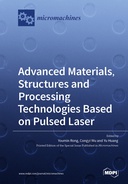Explore

Advanced Materials, Structures and Processing Technologies Based on Pulsed Laser
0 Ungluers have
Faved this Work
Login to Fave
Pulsed lasers are lasers with a single laser pulse width of less than 0.25 s, operating only once in every certain time interval. Commonly used pulsed lasers are nanosecond, femtosecond, and picosecond lasers. A pulsed laser produces short pulses with a short interaction time with the material, which can largely avoid impact on the thermal movement of molecules and has a minimal thermal impact on the surrounding materials, thus having significant advantages in precision microfabrication. It is now widely used in flexible electronics, chips, medicine, and other fields, such as photographic resin curing, microwelding, vision correction, heart stent manufacturing, etc. However, as an emerging processing technology, the application prospects of pulsed lasers have yet to be fully expanded, and there is still a need to continuously explore the mechanisms of interaction with materials, to manufacture advanced functional structures, and to develop advanced process technologies.
This book is included in DOAB.
Why read this book? Have your say.
You must be logged in to comment.
Rights Information
Are you the author or publisher of this work? If so, you can claim it as yours by registering as an Unglue.it rights holder.Downloads
This work has been downloaded 89 times via unglue.it ebook links.
- 89 - pdf (CC BY) at Unglue.it.
Keywords
- contact spacer
- Dermatology
- EBSD
- electrodes
- electrolyte
- hardness
- Laryngology
- laser diodes
- laser micro-cutting
- laser photothermal ablation
- Laser processing
- laser structuring
- laser surface texturing
- laser welding
- Medical applications
- Microstructure
- n/a
- ODS Eurofer
- oxide dispersion strengthened steel
- PET film
- PI film
- pulsed and continuous wave (cw) regimes
- spread area
- tactile sensor
- Technology, engineering, agriculture
- Technology: general issues
- temperature field
- transparent polymer
- ultraviolet nanosecond pulse laser
- wettability
- wetting time
- Zr-based metallic glass
Links
DOI: 10.3390/books978-3-0365-2702-4Editions

